SATURDAY
FEBRUARY 15 - 2014
Flooding
news
For last night's and
today's flooding news and photos please go to . . .
http://www.brook-meadow.hampshire.org.uk/bm-flooding-2014.html
Mystery
stones - further clarification
Following the
discussion in yesterday's blog about the 'eaten
stones' from the Hampshire Farm site, John Arnott
wants to make it clear that the rock boring
bivalves and polychaete worm that he referred to in
his reply are marine not freshwater creatures.
Thus, his supposition that the stones were dumped at
this inland site after being collected at a shore
location near to chalk cliffs. They may have been
mixed with other ballast collected from other sites
which include the limestone rocks. John emphasises
that freshwater bivalves usually lie buried in mud,
sand or gravel beds and that there are no rock boring
freshwater species.
Tony's
news
Tony and Hilary
Wootton walked to Westbourne and back this morning, as
the planned Havant Wildlife Group walk had been
cancelled. They had the pleasure of hearing a
Chaffinch in song near Westbourne - one bird I
have yet to hear, though Ralph Hollins has heard at
least one in Havant. They also spotted what must be
the first Lesser Celandine flower open on Brook
Meadow - just to the west of the main seat. They are
late, or unusually sparse, this year. There are very
few open in Bridge Road car park.
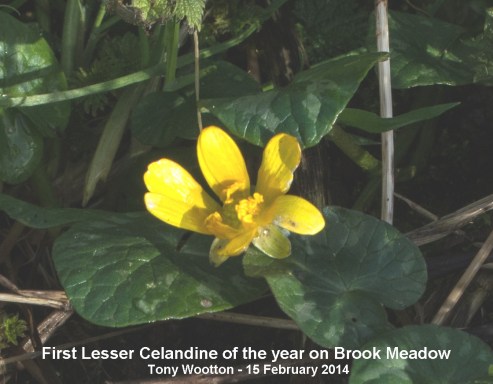
FRIDAY
FEBRUARY 14 - 2014
Flooding
news
The rain was
torrential for most of today until about 3pm. So I was
not all that surprised to find the River Ems a raging
torrent through Brook Meadow, the highest I have seen
it this winter. The water was roaring through the
tunnel under the railway in the north-east corner of
the meadow and was lapping over the top of the line of
black sandbags on top of the brick wall. A couple of
residents of the cottages on Lumley Road were
inspecting the river when I arrived. They were
naturally concerned as their gardens would be
vulnerable if the river went over at this point. They
used some of the bags from the river bank where the
water was not overtopping to raise the level of bags
on the wall, though extra bags would be needed to do
the job properly.
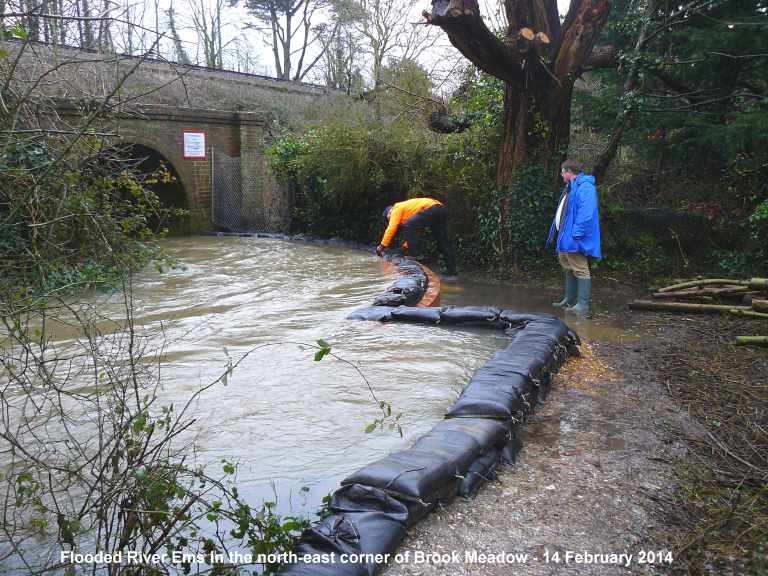
Further down the river
the S-bend had virtually disappeared and water was
gushing over the sluice gate into the already flooded
south meadow, which was deeper than ever. The water
was just a couple of inches below the level of the
Local Nature Reserve sign on the signcase.
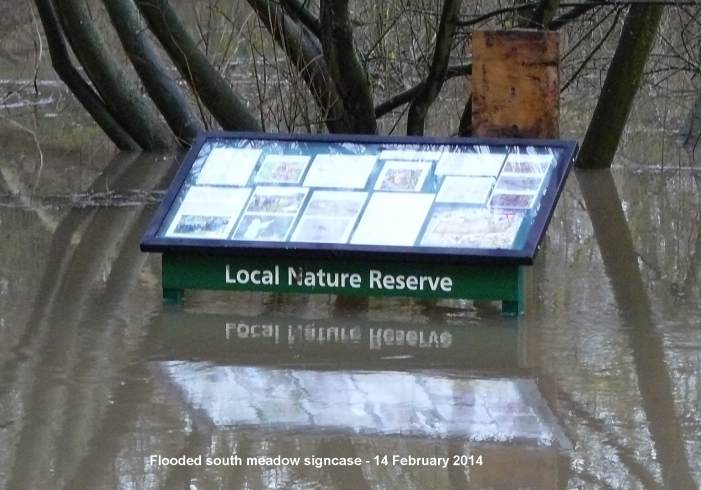
Walking through the
northern part of Palmer's Road Copse as far as the
Water Vole signcase I came across a mass of tiny white
polystyrene beads, of the sort used in bean bags,
washed up on the edge of the flood. I have seen some
of these at this spot before, but not in the quantity
that were there today. I wonder where they came from?
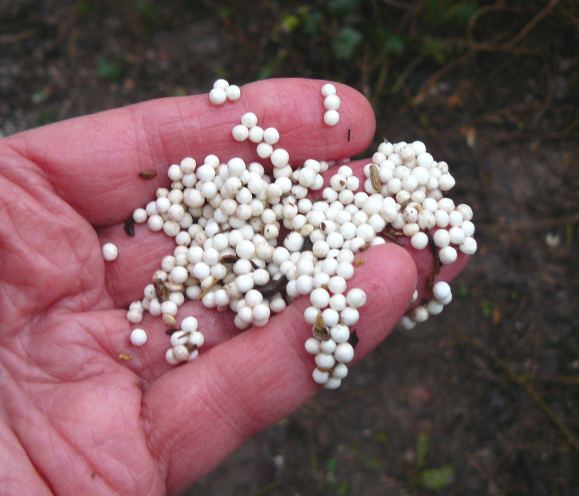
I walked a little way
up Lumley Road where the stream was racing along in
front of the cottages, perilously close to the top of
the bank, though many of the cottages were well
protected with sandbags.
Mystery
stones and shells
Ralph Hollins provided
information about the 'eaten stones' imbedded with
mollusc shells that Chris Oakley found on the
Hampshire Farm site (in yesterday's blog). Ralph says
bivalve molluscs do occur in freshwater as well as in
the sea. There are, in fact, 31 species of freshwater
bivalve that occur in Britain. See . . .
http://www.field-studies-council.org/publications/pubs/freshwater-bivalves-of-britain-and-ireland.aspx
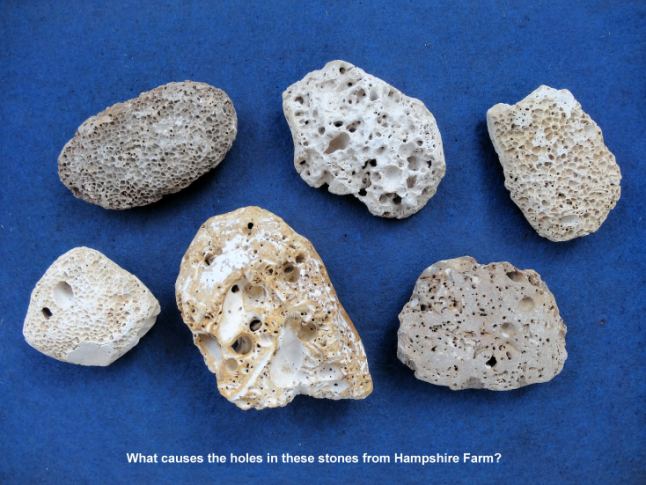
John Arnott also
replied and said the wider and deeper holes were
probably made by the American Piddock
Petricola pholadiformis, a rock boring bivalve.
For more information go to . . . http://jncc.defra.gov.uk/page-1717
John has seen the shells washed up in Chichester
Harbour and this species is well established in the
local chalk. He says there are other rock boring
bivalves such as the Common Piddock Pholas
dactylus and Wrinkled Rock Borer
Hiatella arctica, but it is difficult to tell
without getting the shell out of the burrow. As for
the tiny burrows they were probably made by the
polychaete worm Polydora sp. - again, very
common in the local chalk.
John thinks the stones
were probably dumped as part of the ground restoration
at Hampshire Farm. They are not fossils anyway. The
other indentations may be the result of differential
solution of minerals by seawater, but he's not sure.
Some others are eroded rock partially exposing the
burrows of piddocks at an oblique angle.
Brent
Geese
Maurice Lillie enjoyed
the sight of thousands of Brent Geese in flight during
a walk down the west side of Thorney Island as far as
the Great Deeps. He says the geese were constantly
breaking up and re-forming, flying towards the
harbour, then wheeling back, dividing into relatively
small groups of a one or two hundred and then
re-gathering into untold numbers.
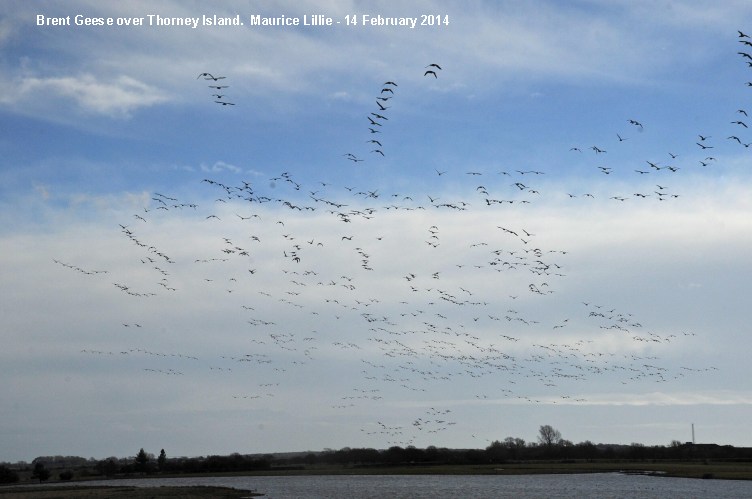
THURSDAY
FEBRUARY 13 - 2014
Emsworth
Quite a nice day in
comparison with yesterday with very little in the way
of rain. I walked through Brook Meadow this morning
where the river remains very high with the water
lapping the wall of sandbags in the north-east corner.
However, there was significantly less water in the
south meadow than over the previous week. The regular
clusters of Crocuses on the Lumley Path are just
starting to open their purple florets.
Down to Slipper
Millpond where Brendan Gibb-Gray was tending to his
small garden. He had seen a Great Black-backed
Gull back on Slipper Millpond near the centre raft
with what looked like one of the juveniles from last
year. But there is little chance they will nest on the
raft this year as it has got numerous wires stretched
across it to deter them. Brendan also told me he had
seen two Little Grebes in Dolphin Lake. The regular
nesting pair of Mute Swans was back on Slipper
Millpond this morning no doubt with a view to
prospecting their nesting site on Peter Pond.
Over to the town
millpond where the two pairs of Mute Swans were well
separated, one pair in the north and the other in the
south. The lone swan was in its usual spot on the
grass verge outside number 14 Bridgefoot Path where I
think it gets fed.
Mystery
stones
Chris Oakley gathered
this group of stones from Hampshire Farm. He keeps
them in the garden just for decoration and asks what
on earth it was that could 'eat' through stone. Looks
like the action of sea water to me, Chris.

Chris points out there
are several holes with shells imbedded in them. Here
is a close-up of one. It looks like a cockle to me.
This suggests the river may have been tidal as far as
Westbourne at some point in history. Does anyone know?
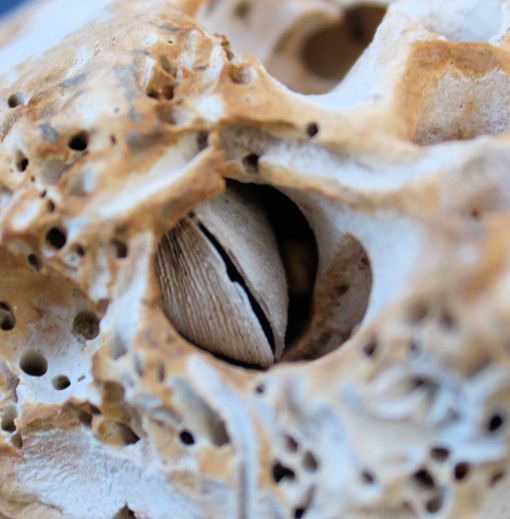
WEDNESDAY
FEBRUARY 12 - 2014
Flooding
news
The weather was so
dreadful today that I did not get out until about 4pm
after lots of heavy rain. Brook Meadow was very wet.
The river was about the same level as yesterday,
though the flooded south meadow was about 6 inches
lower than yesterday. However, the north meadow was
much worse, inundated with water a good 6 inches deep
in parts. In amongst all this water, it was good to
see a couple of tufts of Primroses brightening the
path from the south bridge to the car park. But, how
is it I can never get a decent photo of these flowers?
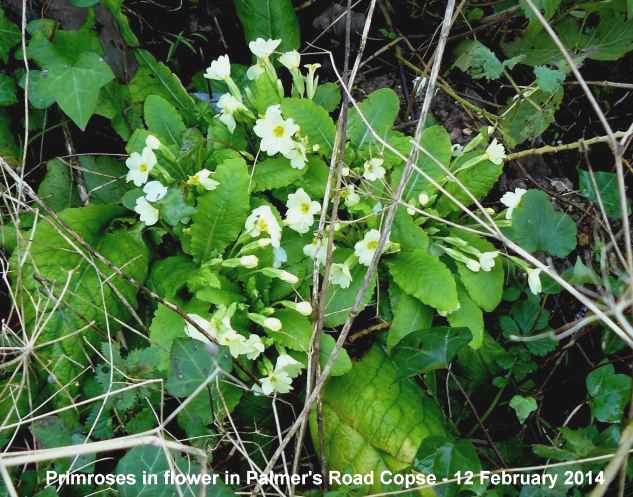
Water
Vole survey - 16th September 2013
Andy Rothwell carried
out his second Water Vole survey on Brook Meadow on
16th September 2013 and his report has just been
received by the conservation group. Good evidence of
Water Voles was found particularly on the River Ems
and to less extent on the Lumley stream. The
predictive equation using the number of maintained
latrines produced an index of 25.4 Water Voles along
the 500m stretch of river, which is double that of
13.1 found in Andy's 2007 survey. Thus, not only is
the River Ems supporting a very healthy population of
Water Voles, but it has increased since 2007. This
finding mirrors our log of Water Vole sightings which
also shows a large increase since 2007.
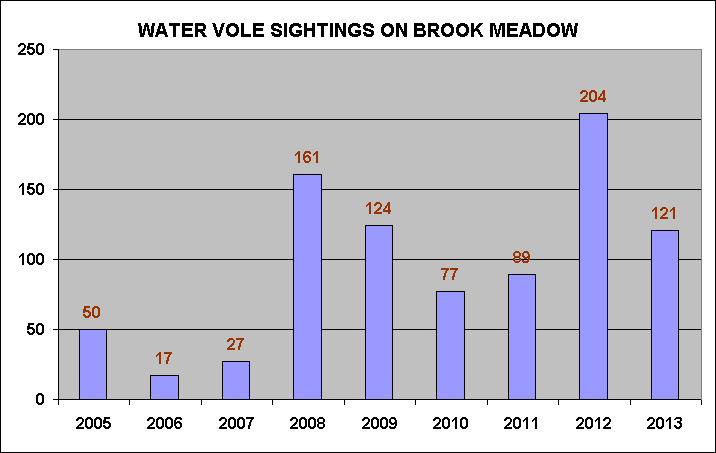
In contrast to the
River Ems, relatively few sightings are got on the
Lumley Stream and Andy's estimated number of Water
Voles using this stream has fallen since the earlier
survey, predictive index down from 8.3 to 2.2.
The survey also found
evidence of Brown Rats in both the River Ems and the
Lumley Stream, but clearly they do not appear to be
having a particualrly negative effect on the Water
Voles. Andy found no evidence of Otter or Mink.
However, he did find many signs of activity of the
smaller Bank Vole, throughout the entire river system
surveyed. Andy makes no mention of Water Shrews, which
suggests that our occasional sightings of them could
be misidentified Bank Voles.
There
is a link to the full report on the Brook Meadow web
site at . . .
Brook
Meadow
Warblington
Langstone
Peter Milinets-Raby
checked the Langstone Mill Pond this morning as well
as the Warblington shore just ahead of high tide
(7:55am to 9am) before the rain and wind came.
Walked in from Wade Lane. In fields here: 4 Mistle
Thrushes, 2 Little Egrets/.
Flooded horse paddock near mill pond: 71 Teal, 21
Moorhen (no Little Egrets).
On Mill Pond: 3 roosting Grey Herons and 2 Little
Egrets.
Off shore: 6 Goldeneye (3 pairs), 18 Red Breasted
Mergansers, Great Crested Grebe.
Fields empty off Pook lane except for 14
Oystercatchers, 120+ Black-headed Gulls and one ad
winter Med Gull.
Last bits of mud/salt marsh off Pook Lane held 22
Lapwing, 128 Dunlin, a single Knot, 5 Grey Plover, a
single Turnstone (so uncommon), 2 Greenshank - both
colour-ringed; RG/YtagY and G-R/BtagR. The former is
probably one of those newly tagged by Pete Potts on
Jan 13.
TUESDAY
FEBRUARY 11 - 2014
Brook
Meadow
What a change from
yesterday! But the rain eased which meant I could get
out by 11:00. Everything in the meadow was very wet,
though the river was about the same level as when I
checked it two days ago. The water was lapping the
bottom of the sandbags in the north-east corner. I
walked down through the north meadow which was very
squelchy and inches deep in water in many parts,
probably due to the height of the water table.
Plenty of bird
activity on the meadow this morning with both Robin
and Dunnock in good voice. A Song Thrush was singing
strongly from the west bank by the industrial units. I
spotted a number of pairs of birds, including Blue
Tits, Great Tits, Blackbirds and Robins.
Yet another Cow
Parsley is in flower, the third one we have had on
Brook Meadow this winter, which is most unusual. It is
located in the gap in the Willow line between the
centre and north meadows. The other two were both on
the causeway. In contrast, I have yet to find a Lesser
Celandine on the meadow.
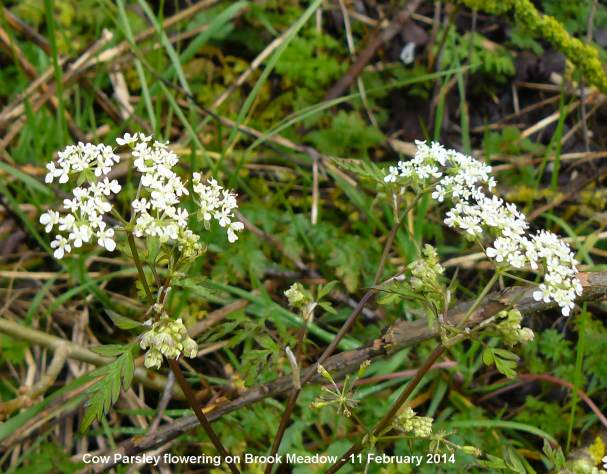
Emsworth
Harbour
I walked from the
Fisherman's Walk along the shore to the quay. The tide
was still well in - about 3 hours after high water. I
could see 5 Greenshank feeding among the
seaweed along the edge of the water, at least one of
which was colour-ringed RG+BY geo. This was one
of 3 Greenshanks that Pete Potts caught at Thorney in
March 2013 and fitted geolocators to the blue rings.
This was the 6th sighting of this bird in Emsworth
Harbour and the 4th so far this winter period.
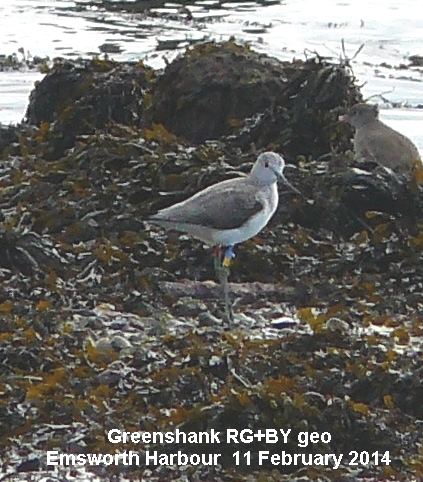
A Brent Goose
family of two adults and four juveniles swam along
in a line close to the shore. The photo shows mum (or
dad) and the four youngsters. The juveniles are
starting to lose their white wing bars.
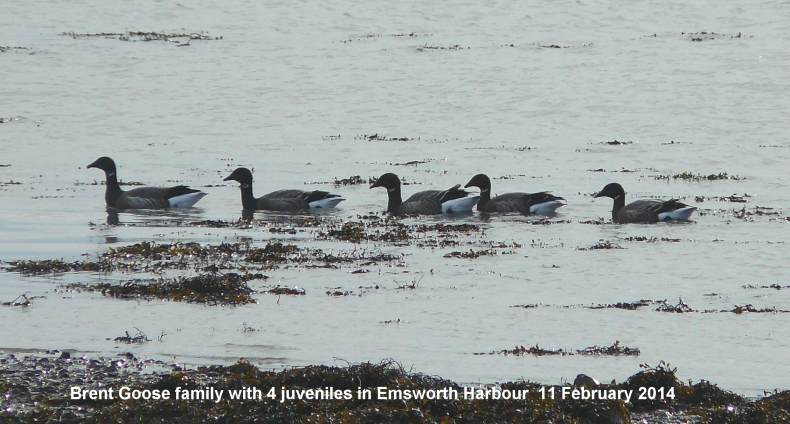
I found another
colour-ringed Greenshank G+BN geo in the
channel to the east of the Emsworth Sailing Club
building. I have only one other sighting of this
ringed bird in Emsworth Harbour which was by Peter
Milinets-Raby on 30-Jan-14. This bird could be one of
the 13 caught and ringed by Pete Potts and his team at
Thorney Deeps on Jan 13. The colour-ringed information
of both the Greenshank seen this morning will be
passed to Anne de Potier who manages the data base for
this species.
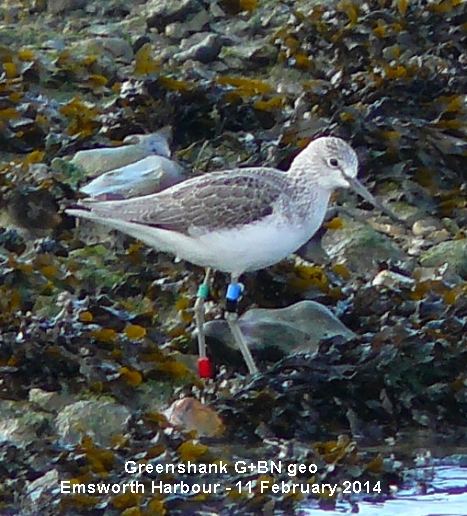
Two large flocks of
Knot were feeding on the western mudflats,
probably the same birds that Peter Milinets-Raby saw
in the eastern harbour on Feb 1. The birds were a long
way out and I did not have my scope with me, but I
took several photos of each flock and, like Peter did
before, I counted the birds in each flock from the
photos. My total count came to 770 which is a little
less than the 934 counted by Peter, but still a
substantial flock for the Solent area. Here is a photo
of the larger flock, typically with the birds
clustered closely together in a bunch (or knot). They
can always be told at a distance from Dunlin which
tend to feed in a line along the edges of channels.
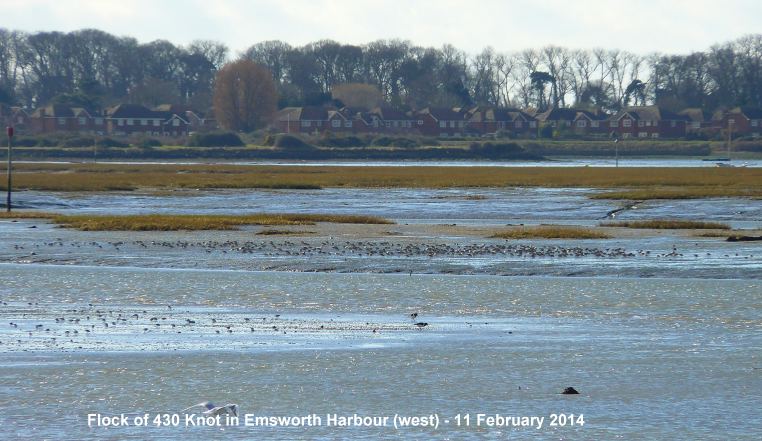
Emsworth
Millpond
The two pairs of Mute
Swans were well separated on the millpond when I
passed this morning, one pair north of the old mill
and the other pair to the south. The south pair might
well attempt to nest in the far south west corner of
the pond, where I recall a 'litter nest' was created a
few years ago.
MONDAY
FEBRUARY 10 - 2014
EMSWORTH
Oh, what a beautiful
morning!! I felt like bursting into song when I felt
the warm sun on my face and the lack of wind. It was
the first time for weeks that I really felt like going
birdwatching down at the harbour.
I started at the town
millpond where the water was low with the sluice gate
open. The two ends of the promenade are still closed
with bags and barriers, but it is easy enough to
clamber over them. The low water gave me an
opportunity to go through the Black-headed Gulls
for colour-rings as most of them were standing on
the mud. I did not see any rings, but did notice
several individual birds were starting to develop
their brown hoods.
Nore
Barn
10:30 - 12:00 - I made
my way along Western Parade to Nore Barn. The tide was
still quite high even though high water was at 8.00.
The sea was dead calm and there was a great view
across the harbour to the towers of Portsmouth which
this photo does not do full justice to.
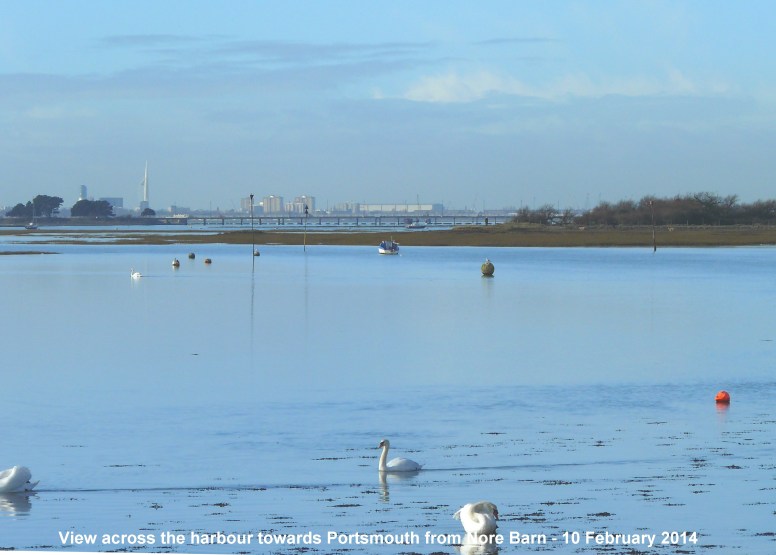
I met Pam Phillips who
said she'd seen the Spotted Redshank about 30 mins ago
being stalked by a chap with a long lensed camera. The
stream was empty when I arrived at about 11:00, though
I could see a Spotted Redshank roosting at the point
of the saltmarshes with gulls. A little later I
watched two Spotted Redshanks feeding along the
seaweed shore at the end of Warblington Road along
with a Greenshank. None of the birds was ringed. I
stood still on the beach and they came to within 5
metres of me, quite unconcerned at my presence and the
constant traffic of people and dogs behind me. The
strong sun and the seaweed background did not make for
a good photo, but here's the best I could manage. The
second Spotted Redshank is half off the photo on the
right.
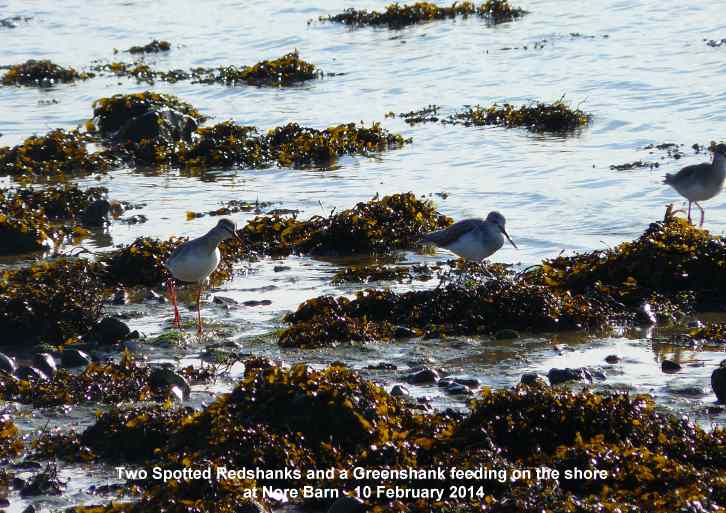
As I was standing on
the beach I looked across the harbour to where a
Sandwich Tern was perched on one of the buoys.
This is probably one of the wintering Sandwich Terns
that Peter Milinets-Raby has seen on several occasions
at high water this winter.
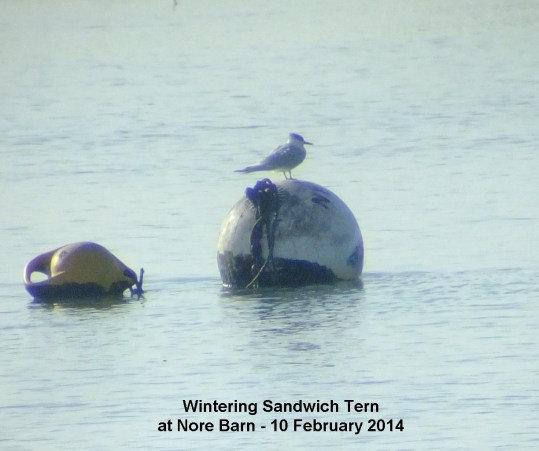
Slipper
Millpond
Back to Slipper
Millpond where I went through the gulls standing on
the mud of the pond, but none were colour-ringed.
However, there were a good few juvenile Black-headed
Gulls from last year's successful breeding with their
brown primaries, orange legs and pale bills.
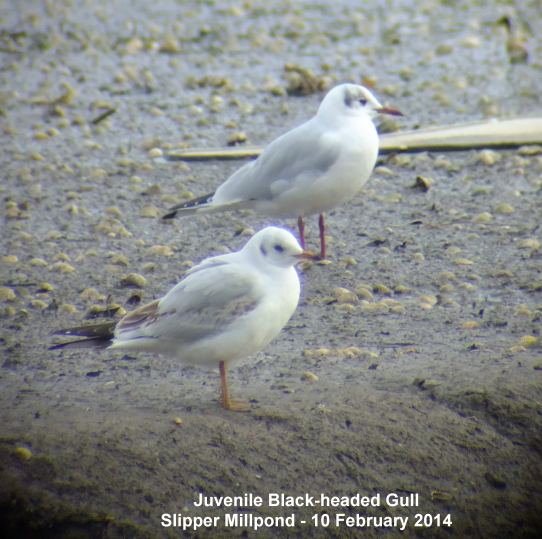
The current low water
in the pond gives us a good opportunity to see the
coral like growths of the Tube worms
(Ficopomatus enigmaticus) which form
colonies on hard objects in the pond. Looked at
closely one can see the coral is made up from hundreds
of tubes projecting from the base to which they are
attached. The one in the photo has grown on the top of
a plastic bottle.
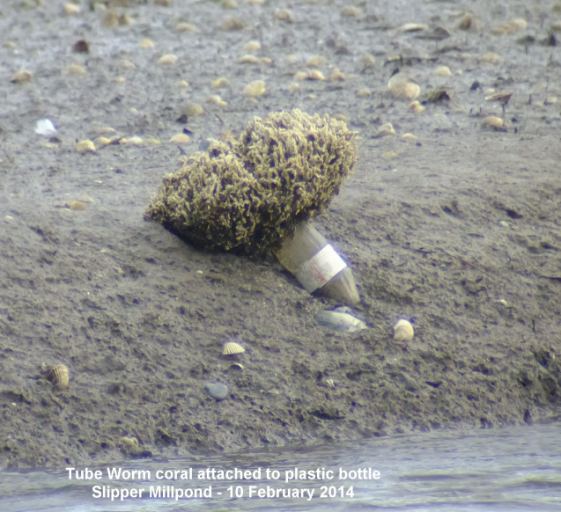
Cherry
Plum 'Pissardii'
Martin Rand responded
to my my plea for help with the identification of the
cherry tree on the causeway on Brook Meadow (see Feb
6):
"Naming your Plum - in
a way both you and Ralph are right; if you have a
red-leaved Cherry Plum that has very pale or white
flowers, then it goes under the scientific name of
Prunus cerasifera var. pissardii. This is also known
by gardeners as Prunus 'Atropurpurea'. It was
originally collected in Iran in the late 19th century.
Varieties with deeper pink flowers are known as Prunus
'Nigra'. 'Hessei' has blotched bronzy leaves and white
flowers; 'Lindasayae' is another pink-flowered form
with upswept branches. But they're all derivatives of
P. cerasifera. The English name Myrobalan Plum is
applied to the species (both type and cultivars).
There are other named subspecies and varieties but
they are mostly quite localised geographical races and
I'm not aware of them being grown in Britain." In view
of Martin's comments I think we can safely call the
tree Cherry Plum - Prunus cerasifera var.
pissardii
Hayling
Oysterbeds news update
Chris Cockburn
provided the following up date from the Oysterbeds:
"Things are beginning
to happen at Hayling Oysterbeds - as I walked towards
the lagoon I was serenaded by several Mediterranean
gulls and as I got closer to the lagoon, I heard a
more raucous but familiar medley off sounds. There
were c60 Black-headed Gulls acting
territorially atop the lagoon's two islands and six
Med gulls doing likewise. Not one of the gulls was in
100% breeding plumage - but it will not be long..!! I
am not sure if Med gulls have been on the islands at
such an early date before; but given the ideal feeding
conditions on the grasslands this wet-winter, they are
probably in tip-top condition. Also present were a few
Common Gulls and two Herring Gulls - none of
which were acting territorially.
No Goldeneyes or
Red-breasted Mergansers this afternoon; but six Little
Grebes, four Oystercatchers and one Curlew were
present (along with the usual Brent Goose family group
with three youngsters). So territorial behaviour has
started four days earlier than in 2012; it is,
presumably, unlikely that any nesting attempts will be
made before the end of March.
Fishbourne
Channel
More exciting news
from Fishbourne Channel comes from the Sunday's SOS
walk led by Andrew House which he said was
surprisingly productive despite the gale force winds
with 3 or 4 Spotted Redshank, 2 Greenshank, at least
500 Black-tailed Godwits. I really must get over there
again. I wonder just how many Spotted Redshanks there
are in the local area? It would also be interesting to
see if any of the shanks were colour-ringed - ie from
the Thorney Island catch on Jan 18.
SUNDAY
FEBRUARY 9 - 2014
Warblington
- Langstone
Peter Milinets-Raby
visited the Warblington shore (arriving along Wade
Lane) and Langstone Mill Pond (10:50am to 12:10pm). So
many Med Gulls were about that it felt like early
spring! The highlights were as follows:
Wade Lane: Flooded fields, Pied Wagtails 6, Mistle
Thrush, Green Woodpecker.
Adult winter Med Gull with 77 Black-headed Gulls on
one of the small puddles
Langstone Mill Pond: 5 roosting Little Egrets, 4
roosting Grey Herons, 4 Teal.
In nearby flooded paddock: A further 41 roosting
Little Egrets (see photo - not quite all of them),
Grey Heron, 46 Teal, 21 Moorhen, 2 Pied wagtails, Male
Pheasant.
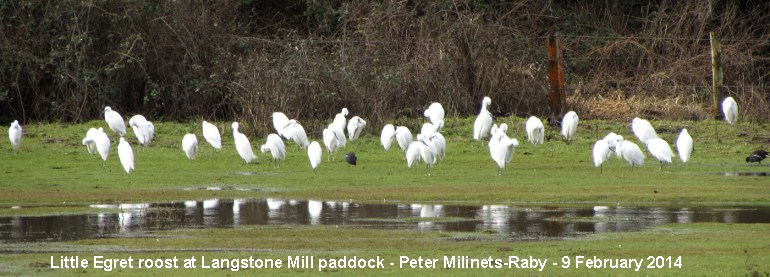
Warblington shore and
fields south of cemetery: 2 Med Gulls (both in full
summer plumage on mud flats), 31 lapwing, 7 Grey
Plover, 5 Knot, 120+ Dunlin, 2 Shelduck, 2 Red
Breasted Merganser, And in fields; 566 Brent Geese,
Black Brant, 10 Oystercatcher, 550+ Black-headed Gulls
with 5 Med Gulls (various ages, 3 ad winters, two
partial summer). Plus 6 Common Gulls.
Red-breasted
Mergansers
Charlie Annalls saw
the photo of the Red-breasted Merganser in yesterday's
blog, which helped her to identify the two birds she
had seen near the Bedhampton slipway. They were male
and female Red-breasted Mergansers and here is
Charlie's photo of the male to complement the female
from yesterday.
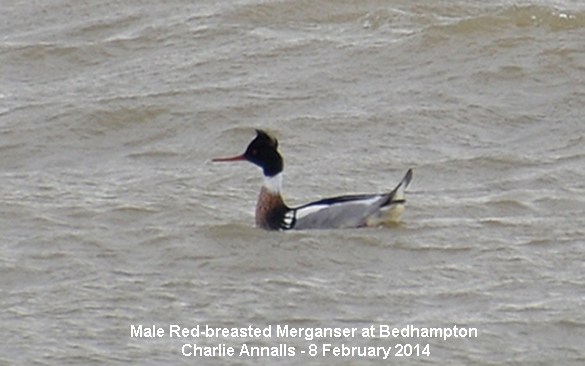
Seaweed
'Passenger'
Chris Oakley was
interested in Heather Mills's picture of the Spider
Crab with 'passengers' that the Havant Wildlife Group
found on Southsea beach yesterday. He believes the
passengers may be a type of seaweed called Jelly
Buttons (Leathesia difformis). He also
pointed out on Heather's photo a scar where another
one has become detached.
Leathesia difformisi are shiny lobe-like
growths which attach themselves to rocks or other
seaweeds. When small, as in Heather's photo, the
capsules are solid, but become hollow and thick-walled
as they grow.
Chris also photographed a small Spider Crab with a
similar seaweed 'passenger' on his Christmas Day trip
to Hayling beach. He thinks they must be one of the
larger varieties as the rooted hold-fast is pretty
sturdy.
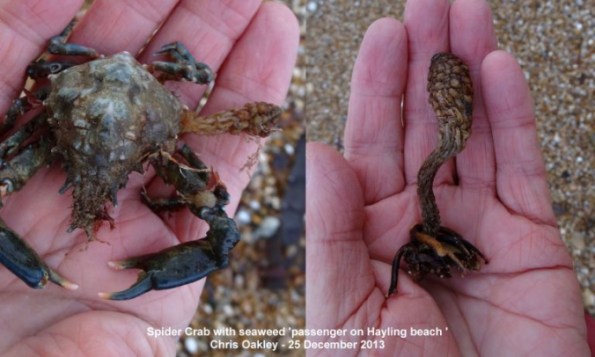
Godwits
return
The first sign of a
return of godwits to the local harbours from the
flooded fields was the presence of around 450
Black-tailed Godwits in Fishbourne Channel, including
many colour-ringed birds reported by Peter Hughes on
the SOS Sightings yesterday (Feb 8). Pete said the
wind/rain/hail made note-taking impossible. So, keep a
look out for them in Emsworth Harbour.
Signs
of spring
On Feb 5 Ralph Hollins
reported that the first Chiffchaff song has been heard
near Hastings, though the Chiffchaff's traditional
role of Harbinger of Spring could be usurped by
Mediterranean Gulls, whose yelping calls will soon be
heard. Ralph says there is "something magical about
hearing the first Med Gull call, especially when it
comes from a clear blue sky in which the bird's pure
white plumage makes it almost invisible".
Ralph also says bird
nesting is already under way for some species and
active nests can now be seen at most Heronries. Closer
to home Ralph saw a newly finished Magpie nest
complete with overhead 'roof' last Sunday (Feb 2) and
has strong suspicions that the recent absence of
female Blackbirds is because they are already sitting
on nests.
SATURDAY
FEBRUARY 8 - 2014
FLOODING
NEWS
Brook
Meadow
I had a walk round
Brook Meadow this morning where the river level was a
few inches higher than it was yesterday. It was
lapping against the black sandbags in the north-east
corner, but not coming through. The water in the south
meadow was also higher, almost reaching up the Local
Nature Reserve sign on the signcase by the south gate.
Here is a view from the path behind the seat.
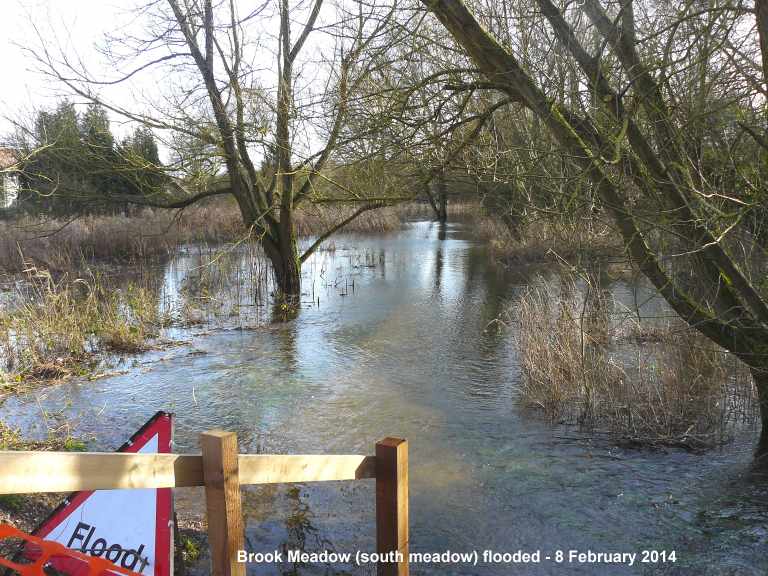
The jolly yellow
flowers of Gorse on the south west corner of Peter
Pond brightened up a stormy morning.
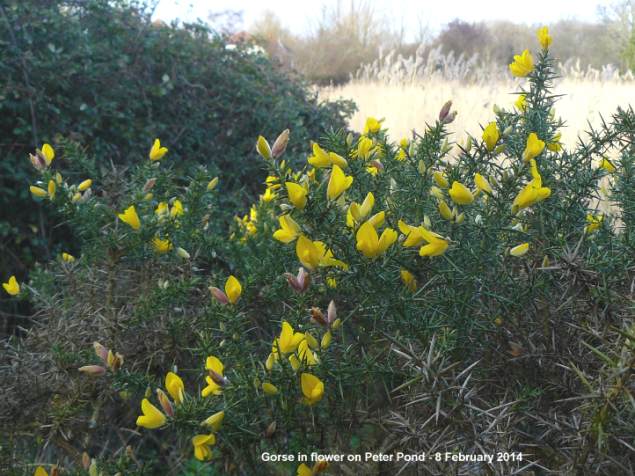
Westbourne
Chris Oakley had a
walk into Westbourne where the river at the road
bridge was about six inches higher than on his last
visit.
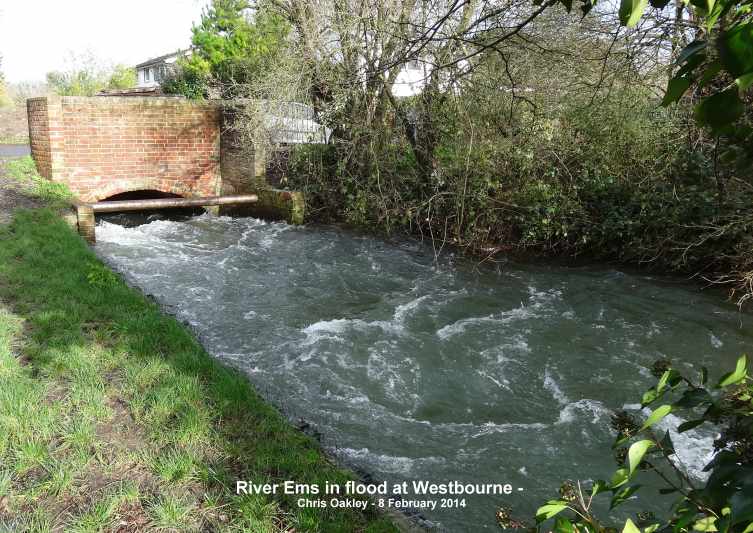
The river had also has
broken over into some of the gardens further upstream.
However, Chris was puzzled that the water level in the
Hampshire Farm pond has remained unchanged for some
weeks and is still only just level with the inlet and
outlet pipes. So where is all the water from the new
estate going? A good question. Does anyone know the
answer?
For
all the flooding news and photos go to . .
. http://www.brook-meadow.hampshire.org.uk/bm-flooding-2014.html
OTHER
NEWS
Merganser
on the millpond
Maurice Lillie managed
to capture a photo of the female Red-breasted
Merganser that has been visiting Emsworth Millpond
from time to time over the past few weeks. I keep
missing it!
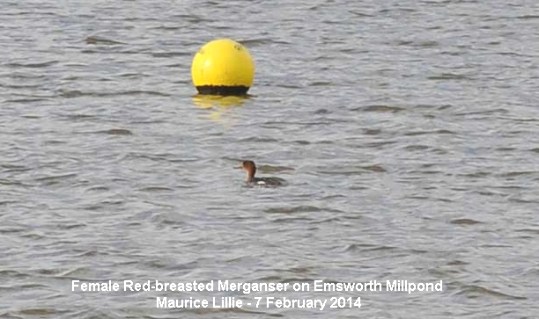
Avocets
at Nutbourne
Janet Hider says
anyone brave enough to walk in this weather may still
get a view of the Avocets at Nutbourne. Her husband
got this excellent image of some of them in flight
this week.
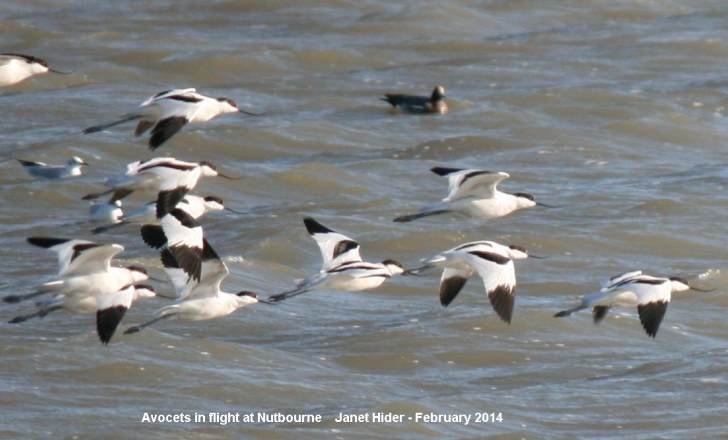
Southsea
adventure
The Havant Wildlife
Group braved the stormy weather this morning and as a
reward had quite an adventure on the beach where they
found masses of things washed up on the beach
including this Spider Crab apparently with
'passengers'.
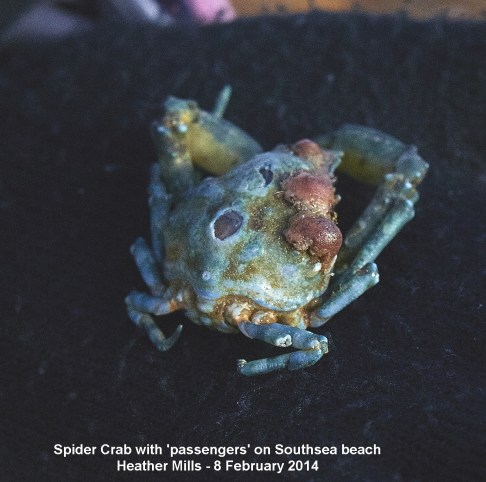
For the full report go
to . . . http://familyfellows.com/hwg-walk-reports-2013.htm
FRIDAY
FEBRUARY 7 - 2014
Flooding
news
I went over to Brook
Meadow this morning to check on the state of the
flooding after last night's rain. The level of the
River Ems was as high as it has ever been, a good 6
inches up on the past week. The water was lapping
against the bottom of the black sandbags in the
north-east corner. The Environment Agency has been
here to reinforce the wall of bags with an extra layer
along the top and another layer along the top of the
brick wall. They have done a good job in difficult
circumstances, so lets hope the bags do not get thrown
into the river as they were last time.
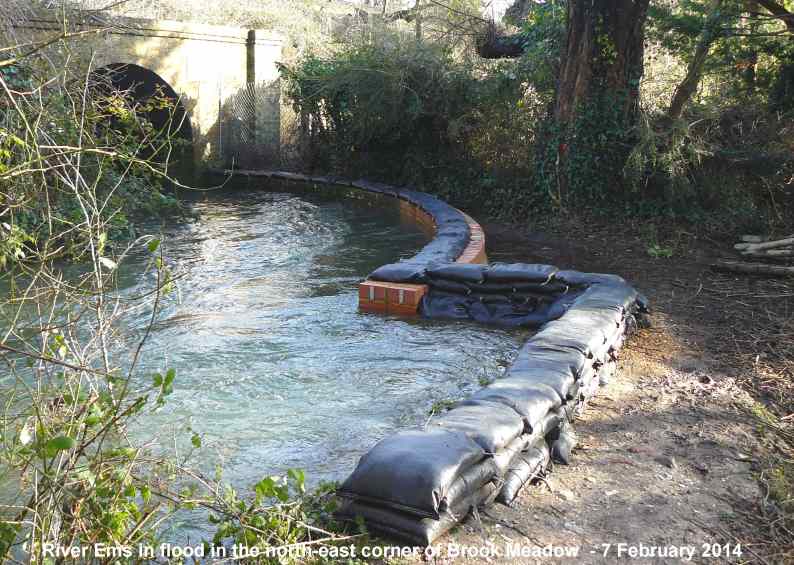
The south meadow is
now totally flooded with the water level just a couple
of inches below the Local Nature Reserve notice on the
signcase at the south gate.
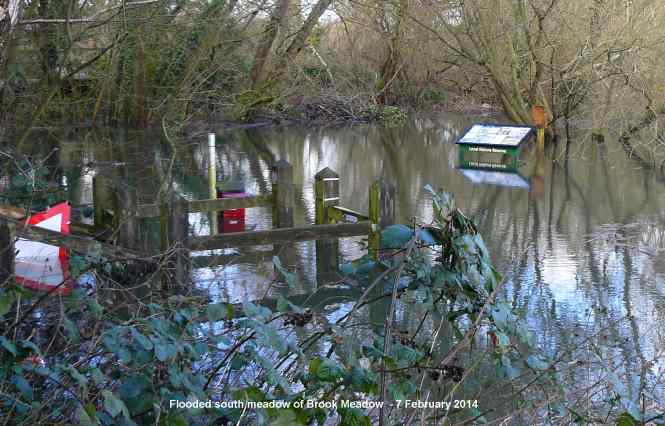
I walked up Lumley
Road to Lumley Mill where the water was rushing
through the new sluice gates and also spilling over
onto the footbridge across the river. The path through
to Seagull Lane was totally flooded as was the large
field to the north of the path. I have never seen it
this bad.
Bird
song
Dunnocks were singing
merrily around the meadow this morning, what a cheery
little song they have. Here is the bird I was
listening to singing from the west bank north of the
north bridge.
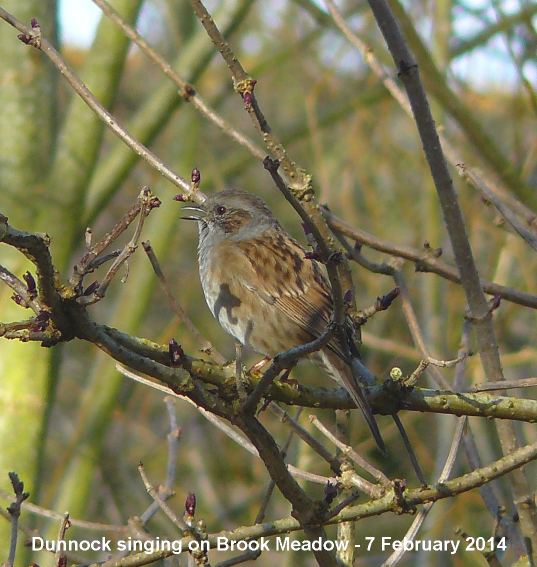
In fact, Dunnock seems
to have taken over from Robin as the main songster for
the time at least. Other birds singing included Song
Thrush, Wren and Great Tit. I also heard my first Blue
Tit song of the winter period from the garden of
Holmwood House in King Street.
Plants
Feverfew is in flower
along Lumley Road. I also spotted just one cluster of
Snowdrops on the bank down to the Lumley Stream, the
first of the year on the Brook Meadow site, though
others may well be beneath the water on the south
meadow. Flower buds are forming on the Cherry Laurels
in the northern end of Palmer's Road Copse.
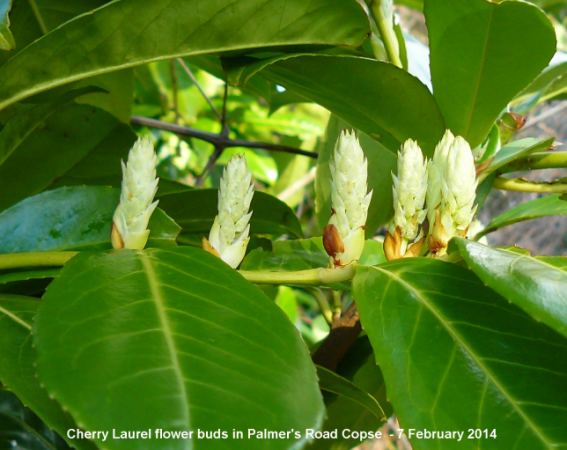
Nore
Barn
14:45 - 15:30 - I
arrived at Nore Barn with the tide rising to high
water in about 2 hours. The Spotted Redshank was
feeding in the stream closely watched by two
birdwatchers, Dave Potter and his friend Martin.
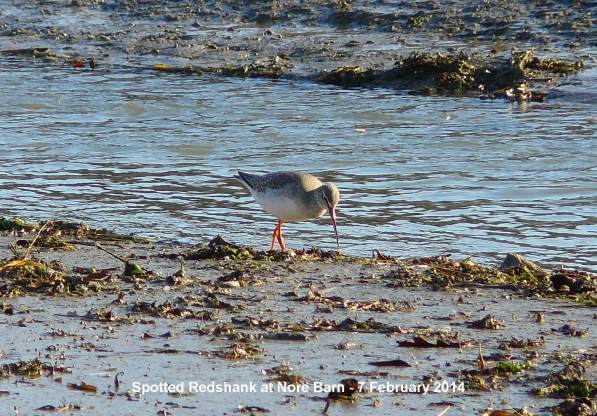
We chatted for a while
about the Spotted Redshank and its 'friends' though
only the Little Egret turned up today. Dave reminded
me of the day in May 2012 when he detected 6 singing
Nightingales along Marlpit Lane, plus two Turtle
Doves. I was doing the official BTO Nightingale survey
at the time and was able to use his sightings.
Other
news
Tony and Hilary
Wootton Hilary had a good walk around Stansted Forest
this afternoon in warm sunshine. Spring's coming!!
They saw a flock of at least 100 Fieldfares
flying over, making Mistle Thrush type clacking
call.
Peter Milinets-Raby
thinks the resident winter population of
Chiffchaffs have decided that spring is on the
way and have decided to move inland as I had three
birds today in different localities. The first was in
his Havant garden, calling and very active as if on a
mission.
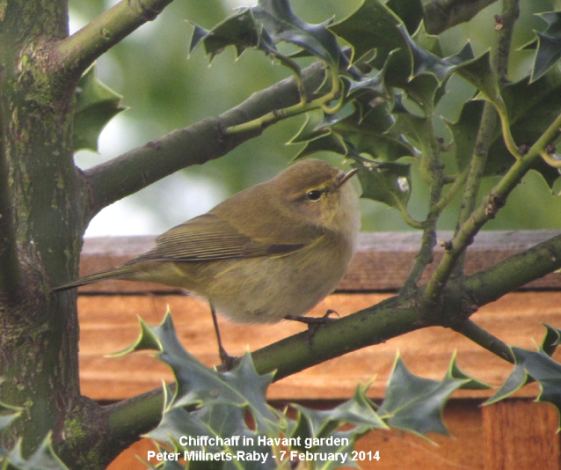
The second was at
Bidbury Mead and the third along the Hermitage Stream
near Barncroft Road, Havant. With Snowdrops, Crocus
and Daffodils out everywhere Peter wonders if spring
has started! That's a bit premature I reckon.
THURSDAY
FEBRUARY 6 - 2014
Myrobalan
Plum?
The Cherry Plum tree
on the causeway on Brook Meadow has just started to
flower for the first time this year. I put report and
this photo of the flower on the blog yesterday.
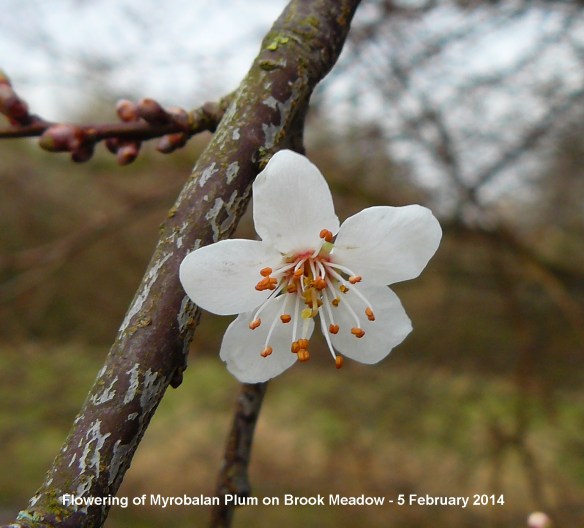
This prompted the
following query from Ralph Hollins: "Seeing your
reference to this tree at Brook Meadow today I had a
look for the species on Google and I see that it has
the same botanic name (Prunus cerasiferus) as
the Cherry Plum which is also starting to flower now.
P. cerasiferus appears in Stace, in the
Hampshire Flora, and in Fitter, Fitter and Blamey with
the only English name for it being Cherry Plum. When I
looked at your tree last year the flowers looked like
Cherry Plum but I could not find any fresh shoots
coloured green which is supposed to be a
distinguishing feature of Cherry Plum. Do you have any
further info on Myrobalan Plum to distinguish it from
Cherry Plum?"
My answer is that I
have always regarded this tree as a type of Cherry
Plum, but not the regular one that one sees growing
wild. As Ralph says, there are some differences,
notably the colour of the leaves which are green in
Cherry Plum and purple in what I have been calling
Myrobalan Plum.
From my researches,
the tree on Brook Meadow is probably the purple leaved
cultivar Pissardii, which is widely grown in suburban
gardens. In fact, we have one in our garden. The Plant
Advice web site gives its common name as Purple-leaved
plum - Prunus cerasifera Cultivar: 'Pissardii'.
http://ww.plantadvice.co.uk/plants/trees/prunus-cerasifera-pissardii/1491
Much more information
on purple-leaved plums is provided by Arthur Lee
Jacobson together with a long list of clones and
hybrids. To quote him, "About 109 years ago (1880), M.
Pissard immortalized his name in the annals of
horticulture by introducing from Persia to France the
first purple leaf plum tree. That original clone,
Prunus cerasifera 'Pissardii' has in turn
produced many seedlings, including hybrids, with more
or less of "purple" color in their foliage.
http://www.arthurleej.com/a-PurpleleafPlumTrees.html
To be on the safe
side, it might be best to refer to the tree on the
causeway on Brook Meadow as a Cherry Plum 'Pissardii'
cultivar, until I hear otherwise. There are some
standard Cherry Plum trees in Palmer's Road Copse near
the car park.
WEDNESDAY
FEBRUARY 5 - 2014
Brook
Meadow
I had a walk through
the meadow this afternoon to check on the state of the
flooding. The river level remains very high and the
water is lapping at the base of the sandbags in the
north-east corner, but not getting through. Water is
still rushing over the sluice gate into the south
meadow which remains a lake. The river is still
flooding over the area known as Palmer's Road Copse.
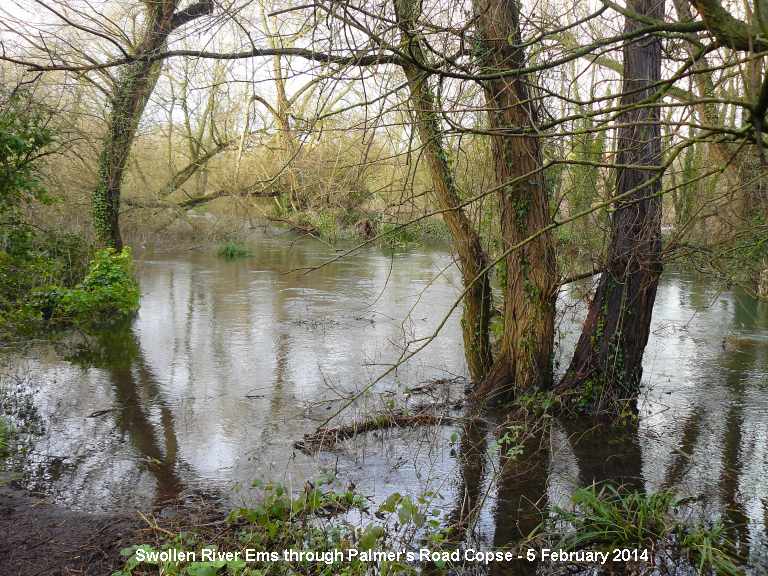
More news and photos
of flooding on Brook Meadow is on the following web
link . . . http://www.brook-meadow.hampshire.org.uk/bm-flooding-2014.html
I stopped to admire
the new willow fence on the river bank near the S-bend
that the conservation group constructed on their work
day on Sunday.
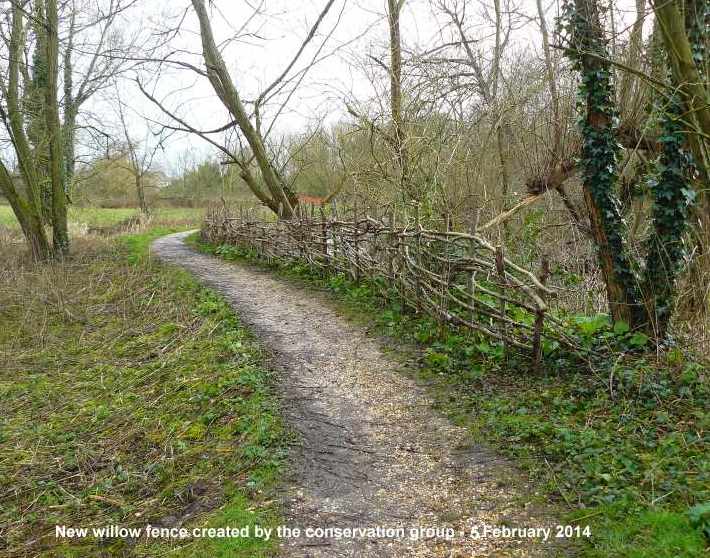
The first flowers are
now open on the old Myrobalan Plum tree on the
causeway, about 2 weeks later than later year. This is
the tree that got blown over in the early 2000s in
similar storms to what we are having now. The
conservation group cut it down to a stump, but it has
sprouted again and is now a substantial and attractive
tree.

Millpond
news
Chris Oakley found the
promenade around the millpond completely closed at
high water this afternoon. The path along Western
Parade to Nore Barn was also inaccessible due to the
high tide.
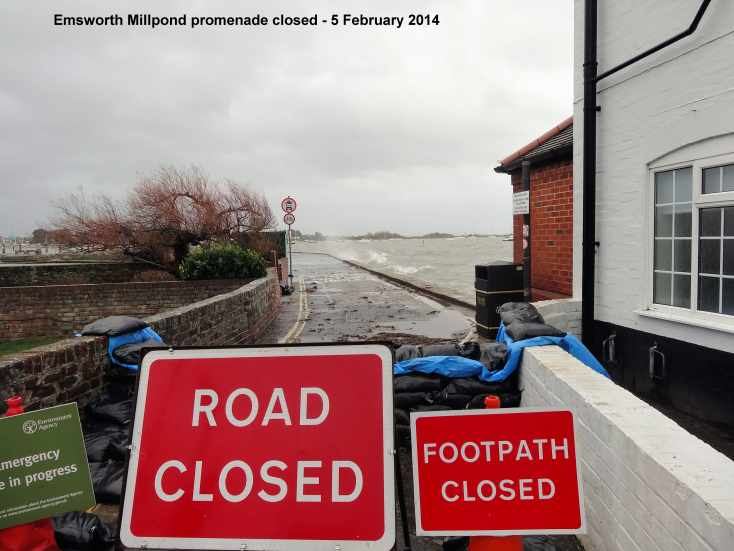
Chris observed that
the Swans on the town millpond remain very territorial
with the north and south pairs each having a
demarcation line, constantly pushing to see how much
the other will tolerate. The encounter is likely to
become more physical as the spring approaches and
their hormones really start to flow.
Colin's
photos
Colin Vanner said the
Bearded Tits were showing well at Farlington Marshes
on Saturday. Here's a fine image of a female that he
captured.
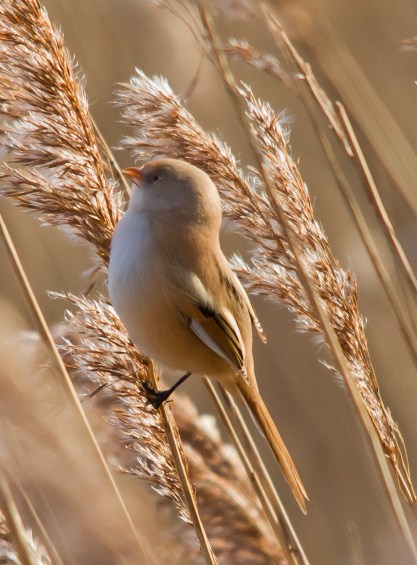
Colin also saw (and
was seen by) this Roe Deer in woodland near Southwick.
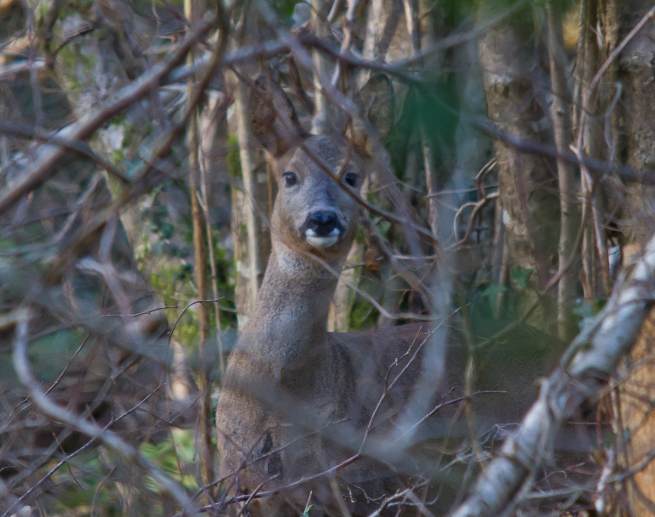
MONDAY
FEBRUARY 3 - 2014
Nore
Barn
Just one Spotted
Redshank was feeding in the stream when I looked in at
about 12 noon. The wind was too strong for any serious
birdwatching.
Colin's
photos
Colin Vanner said the
Bearded Tits were shoing well at Farlington Marshes on
Saturday. Here's a fine image of a male that he
captured.
Colin also saw (and
was seen by) this Roe Deer in woodland near Southwick.
SATURDAY
FEBRUARY 1 - 2014
BROOK
MEADOW
Flooding
The level of the river
was much higher this morning than over the past week,
following yesterday's rain. And there is more rain to
come today. The mini wall of black sandbags has been
replaced on the river bank in the north-east corner of
the meadow to keep the flow inside the corner. The
water was lapping at the base of the bags, but well
below the top. The water level was about 6 inches from
the top of the brick wall. Thanks to Maurice Lillie
for the photo.
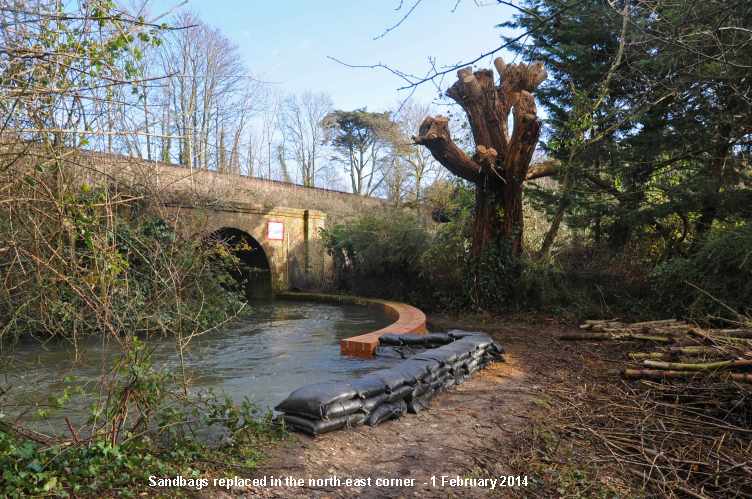
The water level in the
south meadow was also up on the past few days as it is
in Palmer's Road Copse where the Deep Water sign is
almost completely submerged. The S-bend had also
virtually disappeared in the flooded river. Thanks to
Maurice Lillie for the photo.
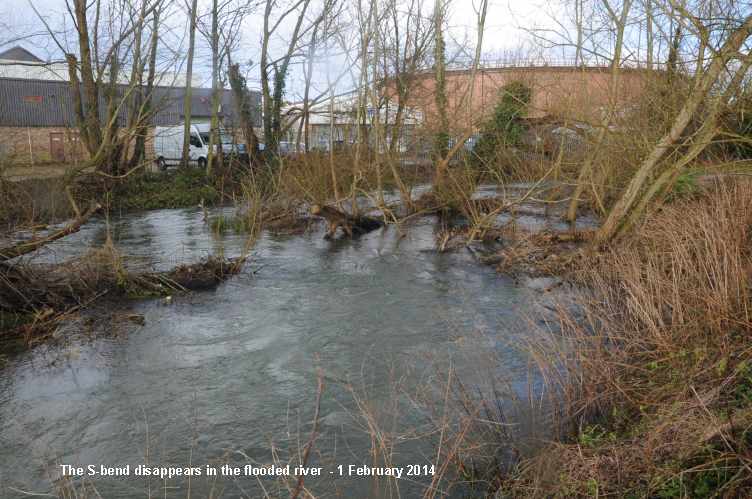
Birds
Malcolm Phillips went
looking for birds this morning. Not a lot about he
said, but he managed to capture these nice images of
two of our most common birds.
Great
Tit singing its 'teacher' song
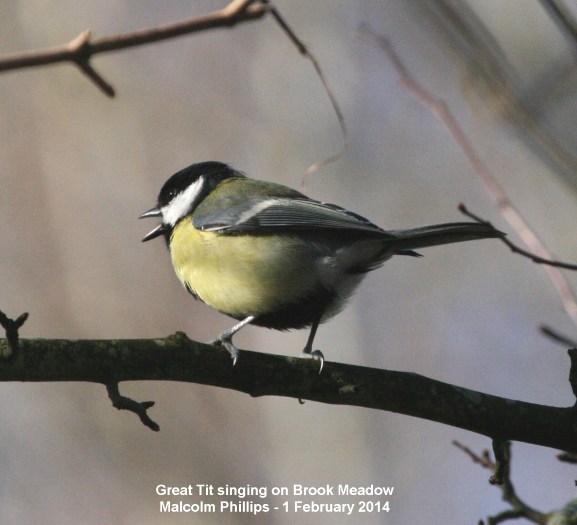
Wren
is probably our most numerous resident
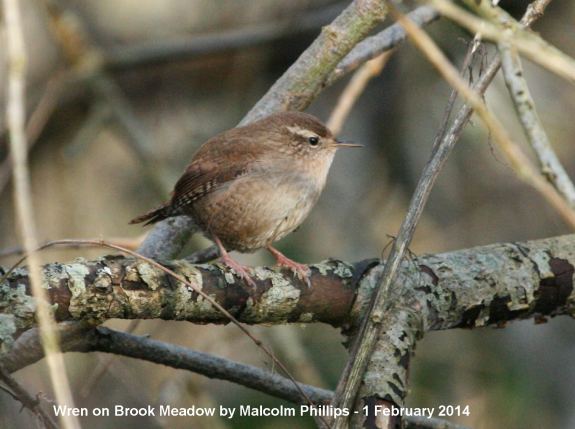
Emsworth
to Warblington
Yesterday (Jan 31)
Peter Milinets-Raby walked along the shore from
Emsworth Mill Pond to Nore Barn (8am to 8:55am) and
then later to the Warblington shore (9am to 10am).
Here are the highlights:
Emsworth Harbour:
934 Knot (counted from a series of photos - the
birds were closer to shore and clearly in larger
numbers - chilly weather perhaps). 17 Shelduck. 800+
Dunlin. 140+ Brent Geese. 1 Sandwich Tern hawking
along the channels. 2 Pintail. 7 Grey Plover.
Nore Barn: 212 Dunlin,
8 Knot, 91 Brent Geese, 107 Wigeon, 104+ Teal, 9
Shelduck, 2 Spotted Redshank (not quite in the
stream). 6 Gadwall, 4 Pintail.
Warblington: In
cemetery - Sparrowhawk, Kestrel and Green Woodpecker.
Med gull ad winter in with 350+ Black-headed Gulls and
12 Common Gulls in churned up field next to farm.
Off Conigar Point: 177
Dunlin, 2 Great Crested Grebes, 21 Grey Plover, 27
Lapwing, 3 Pintail, 23 Curlew, 29 Shelduck, 125 Brent
Geese, 41 Wigeon, 4 Red Breasted Merganser. In field
behind point - 15 Skylarks and 7 Stock
Doves.
The first section of
sea wall south of the cemetery has three huge chunks
of concrete panelling removed by the sea and I fear
that more damage could be done, especially with the
high tides expected over the next few days!
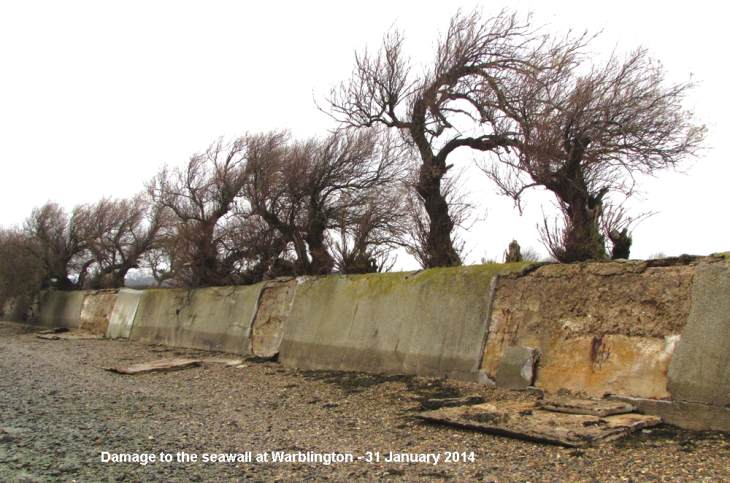
Garden
birds
Patrick Murphy had a
busy time in his garden yesterday with 7 Goldfinches
ground feeding and a further 4 or 5 on the feeders
above them. He also had a Song Thrush, one of a pair
of daily visitors and a flock of Long Tailed Tits
invading his fat ball container.
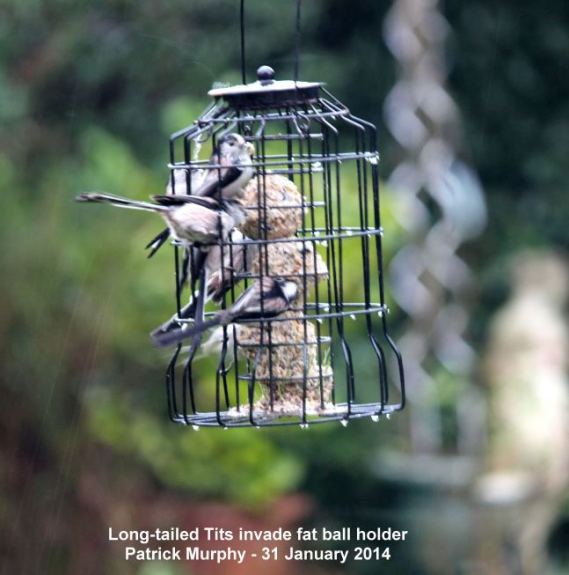
For
earlier observations go to . . . January
17-31